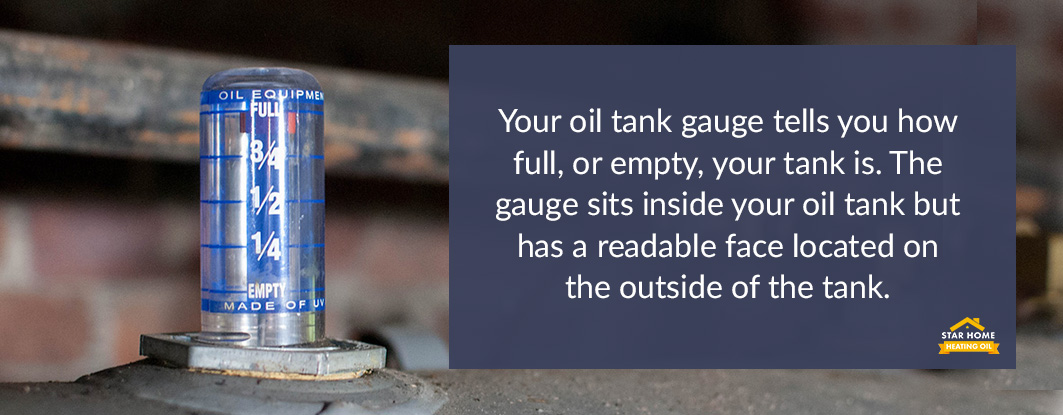How Do I Know How Much Heating Oil is in My Tank?
Most residential heating oil tanks are equipped with a tank gauge to help you understand how full or empty your tank is. Sometimes, however, these tank gauges can malfunction or cease to operate properly.
How To Read An Oil Tank Gauge
Your oil tank gauge tells you how full, or empty, your tank is. The gauge sits inside your oil tank but has a readable face located on the outside of the tank.

These tank gauges display the level of oil remaining inside your tank – not the actual number of gallons left inside. That means the gauge will tell you what percent of your tank is full.
This concept should already be familiar to you. Most cars are equipped with an oil tank gauge on the dashboard that doesn’t show how many gallons remains inside the tank. Instead, the gauge shows you what percentage of your heating oil tank is full or still available. That is exactly how your home heating oil tank gauge works as well.
If for some reason your heating oil tank gauge isn’t working, you can choose to fix your oil tank gauge or simply opt for taking a manual reading of what is left inside the tank.
How to Manually Measure How Much Oil is in Your Tank
Taking a manual reading involves using a measuring stick and inserting it inside the tank. The oil inside the tank will “mark” the stick at a certain level. From there, you will reference your tank size and dimensions against a measurement chart to understand how that stick measurement converts to the number of gallons likely left in your tank.
1. Get a gauge stick
You might hear people refer to a gauge stick as a “tank stick”, a “measuring stick”, or a “dipstick”. Despite the different terminology, they are all referring to the same thing.

Some people use a simple wooden yardstick or metal rod for this function, but we have found that the best gauge sticks are those that are varnished. Varnished gauge sticks get the most accurate reading possible because they limit the spread of the oil on the stick.
Regardless of what material stick you use, be sure the stick you choose is straight — not warped or bent.
2. Measure the Contents of the Tank
First, turn the top fill valve cap counterclockwise and remove the cap from the tank. Lower the stick gently into the tank until you feel it touch the bottom. Once you feel it hit the bottom of the tank, slowly bring the stick back up. Read the depth of oil to the nearest eighth of an inch.
Next, wipe the measuring stick down with a dry cloth or paper towel in preparation for a second dip into the tank. It is always best to take two readings just in case.
Gently lower the stick back into the tank for the second time. When the stick hits the bottom of the tank, bring it back up and record your second reading.
Be sure to clean up any mess you may have made and secure the top fill valve cap back on to prevent any leaking.
3. Convert Measurements
Once you have measured the level in your oil tank, you need to understand what that information means. To do so, you must convert the number of inches on your gauge to gallons. You will need a fuel oil tank chart to help you do this. Find your tank size and compare it with the inches you see on your measurement. Subtract the total number of gallons in the tank from the size capacity of your oil tank to see how much space remains.
Re-Fill Your Oil Tank with Star Home Heat
If you are looking for a fill up but don’t know how much fuel is left in your tank, don’t worry. Most residential homes are equipped with a 275-gallon capacity tank. Even if your tank is bigger or smaller than that, Star Home Heat’s team of service providers will be happy to provide you with a safe tank fill.
Enter your zip code to get started and select “Fill Up My Tank”. If you don’t know your tank size, just select “I don’t know”. Your service provider will handle it from there.


